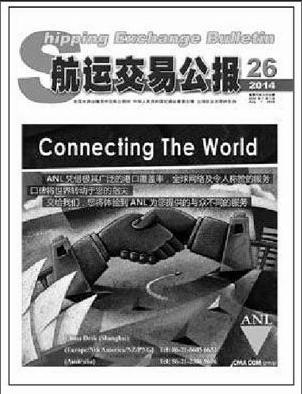Weekly Commentary on China Containerized Transportation
2014-09-05LiuZijia
Liu+Zijia

In the week ending June 20, China export container market was stable overall. As large inject of capacity, freight rate in the majority ocean-going services declined, except for the South America service, which saw demand/supply condition improved and spot rate rose against last week. On June 20, China (Export) Containerized Freight Index (CCFI) issued by Shanghai Shipping Exchange (SSE) quoted 1093.45 points, down by 0.9 percent from last week; while Shanghai (Export) Containerized Freight Index (SCFI) issued by SSE declined by 3.0 percent to 1042.82 points.
In the Europe service, as the approach of traditional peak season, cargo volume kept increasing firmly, but as large number of mega vessel being put into service, the capacity was expanded largely. On June 20, the freight rate in the Shanghai-Europe service (covering seaborne surcharges) quoted USD1120 per TEU, down by 6.8 percent from last week. In the Mediterranean service, the market was cooled somehow. The average slot utilization rate of this service was in the range from 90 percent to 95 percent, with spot rate slipping further. On June 20, the freight rate in the Shanghai-Mediterranean service (covering seaborne surcharges) quoted USD1595 per TEU, down by 4.5 percent from last week.
Transport demand was stable basically in the North America service. In the West Coast of this service, the average slot utilization rate declined to below 90 percent, with some even at 85 percent. In the East Coast of this service, the average slot utilization rate above 95 percent , with some even full loaded. Most box liners reduced freight rate by around USD50 per FEU to lock cargo source. On June 20, the freight rates in the China-USWC and USEC services quoted 951.29 points and 1222.81 points, almost unchanged from last week.
In the Persian Gulf/Red Sea service, transport demand slipped sharply, and demand/supply condition had no evident improvement, leading to the average slot utilization rate hovering at around 80 percent. The average spot rare in the Persian Gulf fell to USD850 per TEU, and that in the Red Sea service decreased to USD11300 per TEU. On June 20, the freight index in the China-Persian Gulf/Red Sea service quoted 1299.05 points, down by 5.9 percent against last week.
In the Australia service, cargo volume was flat, although AADA members took turns at ceasing services, the demand/supply condition was not improved remarkably, resulting the average slot utilization rate in the range of 80%-85%. Spot rate kept on unilaterally declining for 3 months, with some below USD300 per TEU. On June 20, the freight index in the China-Australia service quoted 766.33 points, down by 3.2 percent.
Cargo volume kept increasing in the South America service, the reason was that the market was entering into the traditional peak season, and the “World Cup” is scheduled to be end when the cargo which are shipped at present arrive at the East Coast of South America service, which boosted the cargo volume. As a result, the average slot utilization rate in this service amounted to be above 90 percent, with some even approaching 95 percent. On June 20, the freight index in the Shanghai-South America service (covering seaborne surcharges) quoted USD1194 per TEU, surging by 12.9 percent against last week.
Cargo volume kept flat recently in the Japan service, where the average slot utilization rate stood below 60 percent, with spot rate slipping. On June 20, the freight index in the China-Japan service fell by 4.3 percent to 627.05 points.
(Please contact the Information Dept of SSE for more details.)endprint
